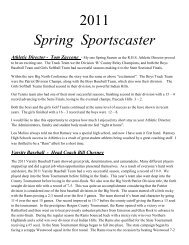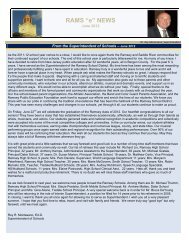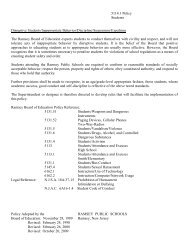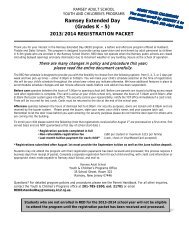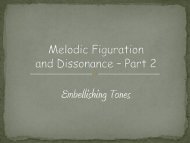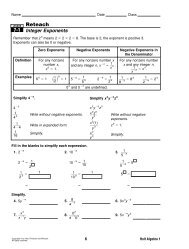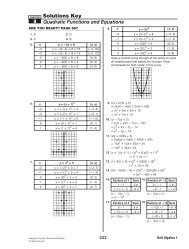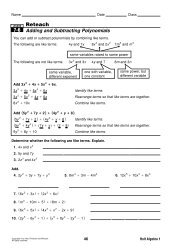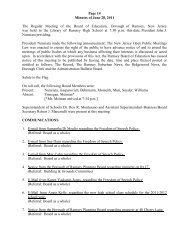Pre-Algebra Chapter 9
Pre-Algebra Chapter 9
Pre-Algebra Chapter 9
You also want an ePaper? Increase the reach of your titles
YUMPU automatically turns print PDFs into web optimized ePapers that Google loves.
The most common unit of measure for angles<br />
is the degree. A circle can be separated into<br />
360 arcs of the same length. An angle has a<br />
measurement of one degree if its vertex is at<br />
the center of the circle and the sides contain<br />
the endpoints of one of the 360 equal arcs.<br />
You can use a protractor to measure angles.<br />
1 degree (˚)<br />
Example 1<br />
Measure Angles<br />
a. Use a protractor to measure CDE.<br />
Step 1<br />
Place the center point of<br />
the protractor’s base<br />
on vertex D. Align the<br />
straight side with side<br />
DE so that the marker<br />
for 0° is on the ray.<br />
20<br />
160<br />
10<br />
170<br />
30<br />
150<br />
40<br />
140<br />
C<br />
50<br />
130<br />
60<br />
120<br />
70<br />
110<br />
80<br />
100<br />
D<br />
90<br />
100<br />
80<br />
110<br />
70<br />
60<br />
120<br />
50<br />
130<br />
140<br />
40<br />
150<br />
30<br />
160<br />
20<br />
170<br />
10<br />
E<br />
Step 2<br />
Use the scale that begins<br />
with 0° at DE . Read<br />
where the other side of<br />
the angle, DC , crosses<br />
this scale.<br />
20<br />
160<br />
30<br />
150<br />
120˚<br />
C<br />
40<br />
140<br />
50<br />
130<br />
60<br />
120<br />
70<br />
110<br />
80<br />
100<br />
90<br />
100<br />
80<br />
110<br />
70<br />
60<br />
120<br />
50<br />
130<br />
140<br />
40<br />
150<br />
30<br />
160<br />
20<br />
Reading Math<br />
The measure of angle CDE is 120°.<br />
Using symbols, mCDE 120°.<br />
10<br />
170<br />
D<br />
170<br />
10<br />
E<br />
Angle Measure<br />
Read mCDE 120˚ as<br />
the measure of angle CDE<br />
is 120 degrees.<br />
b. Find the measures of KXN,<br />
MXN, and JXK.<br />
mKXN 135°<br />
XN is at 0° on the right.<br />
K<br />
40<br />
140<br />
50<br />
130<br />
60<br />
120<br />
70<br />
110<br />
80<br />
100<br />
90<br />
100<br />
80<br />
110<br />
70<br />
M<br />
60<br />
120<br />
50<br />
130<br />
140<br />
40<br />
mMXN 70°<br />
XN is at 0° on the right.<br />
mJXK 45°<br />
XJ is at 0° on the left.<br />
J<br />
20<br />
160<br />
10<br />
170<br />
30<br />
150<br />
X<br />
150<br />
30<br />
160<br />
20<br />
170<br />
10<br />
N<br />
Protractors can also be used to draw an angle of a given measure.<br />
Example 2<br />
Draw Angles<br />
Draw X having a measure of 85°.<br />
Step 1 Draw a ray with endpoint X.<br />
X<br />
Step 2<br />
Step 3<br />
Place the center point of the<br />
protractor on X. Align the<br />
mark labeled 0 with the ray.<br />
Use the scale that begins<br />
with 0. Locate the mark<br />
labeled 85. Then draw the<br />
other side of the angle.<br />
20<br />
160<br />
10<br />
170<br />
30<br />
150<br />
40<br />
140<br />
50<br />
130<br />
60<br />
120<br />
70<br />
110<br />
80<br />
100<br />
X<br />
90<br />
100<br />
80<br />
85˚<br />
110<br />
70<br />
60<br />
120<br />
50<br />
130<br />
140<br />
40<br />
150<br />
30<br />
160<br />
20<br />
170<br />
10<br />
448 <strong>Chapter</strong> 9 Real Numbers and Right Triangles



